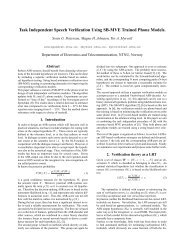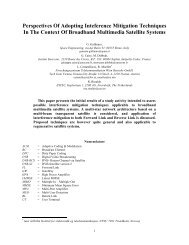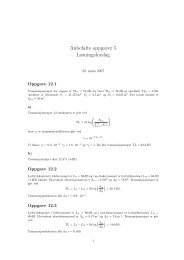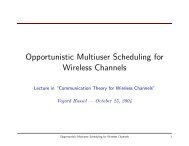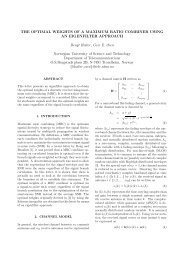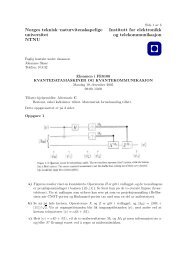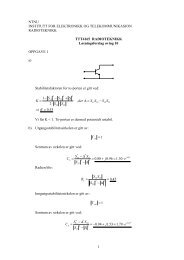Polarization and Polarization Controllers - NTNU
Polarization and Polarization Controllers - NTNU
Polarization and Polarization Controllers - NTNU
You also want an ePaper? Increase the reach of your titles
YUMPU automatically turns print PDFs into web optimized ePapers that Google loves.
<strong>Polarization</strong> <strong>and</strong> <strong>Polarization</strong> <strong>Controllers</strong><br />
Vegard L. Tuft (vegard.tuft@iet.ntnu.no)<br />
Version: September 14, 2007<br />
Abstract: This document is an introduction to polarization controllers <strong>and</strong> their<br />
applications in fiber optical communication systems. Using Jones representation, it<br />
provides a mathematical overview of polarization before describing the concept of wave<br />
plates <strong>and</strong> how to cascade wave plates to form a polarization controller. The principles of<br />
operation of two different controllers are described: Lefevre’s three-loop rotating wave<br />
plate device <strong>and</strong> General Photonics’ PolaRite rotating variable-phase controller.<br />
1 Introduction – Why <strong>Polarization</strong> <strong>Controllers</strong>?<br />
Figure 1 illustrates a situation in which light from a laser is guided by an optical fiber <strong>and</strong> enters an<br />
optical component. In many cases the performance of the component depends on the polarization of the<br />
light. Wavelength multiplexers, wavelength converters, modulators, amplifiers, interferometers <strong>and</strong><br />
some receivers are examples of devices that are polarization sensitive. An irregular fiber core as well as<br />
thermal <strong>and</strong> mechanical stress causes the light to change its state of polarization (SOP) as it propagates<br />
in st<strong>and</strong>ard single-mode fibers - this in a r<strong>and</strong>om <strong>and</strong> time-varying way due to ever-changing<br />
environmental conditions. The time-varying polarization states can also cause r<strong>and</strong>om pulse spreading<br />
<strong>and</strong> signal distortions as the signal propagates through the fiber, a phenomenon called polarizationmode<br />
dispersion (PMD). Therefore, in order to overcome these challenges, we need a device that can,<br />
in a controllable <strong>and</strong> predictable way, change the SOP into the desired state at the fiber output.<br />
Laser<br />
Fiber optic<br />
transmission line<br />
<strong>Polarization</strong> controller<br />
Figure 1: Basic transmission system with polarization controller.<br />
Optical<br />
component<br />
This document first summarizes the mathematical foundation for describing <strong>and</strong> analyzing such a<br />
device, by using Jones representation of the light <strong>and</strong> the Poincaré sphere. Then, we analyze cascaded<br />
wave retarders <strong>and</strong> the principle of operation of polarization controllers. The retarders are often refered<br />
to as wave plates. Furthermore, two fiber optic implementations using rotating wave retarders are<br />
presented. Finally, we will have a brief look at three typical applications of polarization controllers in<br />
optical communication systems: polarization optimization, PMD compensation, <strong>and</strong> de-multiplexing of<br />
polarization multiplexed signals.<br />
2 Mathematical Description of Polarized Light<br />
2.1 The <strong>Polarization</strong> Ellipse<br />
We will in the following consider a monochromatic optical field of frequency ν <strong>and</strong> wavelength λ<br />
traveling in the z direction through a st<strong>and</strong>ard step-index single mode fiber. In the scalar<br />
approximation, which is valid when the difference between core <strong>and</strong> cladding refractive index is small,<br />
we can write the field as a transversal mode Ψ(x,y) in the (x,y) plane perpendicular to <strong>and</strong> independent<br />
of the propagation direction:<br />
( E xˆ<br />
+ E ˆ ) Ψ( x y)<br />
E = y , (1)<br />
x y ,
where<br />
{ }<br />
{ }<br />
i<br />
( )<br />
( τ + 1<br />
τ + δ<br />
)<br />
1 = R a1e<br />
i<br />
( )<br />
( τ + δ 2<br />
τ + δ = R a e<br />
)<br />
1 cos δ<br />
E = a<br />
(2a)<br />
x<br />
E = a2 cos 2 2 . (2b)<br />
y<br />
τ = ωt-βz, where ω = 2πν is the angular frequency <strong>and</strong> β = 2π/λ is the propagation constant of the mode.<br />
By eliminating τ between E x <strong>and</strong> E y into (2a-b) we obtain the equation of the polarization ellipse [1]<br />
⎛ E<br />
⎜<br />
⎝ a<br />
x<br />
1<br />
⎞<br />
⎟<br />
⎠<br />
2<br />
⎛ E<br />
+ ⎜<br />
⎝ a<br />
y<br />
2<br />
⎞<br />
⎟<br />
⎠<br />
2<br />
E E<br />
x y<br />
− 2 cosδ<br />
= sin<br />
a a<br />
1<br />
2<br />
2<br />
δ . (3)<br />
δ = δ 2 - δ 1 is the phase difference between the x <strong>and</strong> y components of the electrical field. This ellipse is<br />
in general rotated through an angle ψ, as illustrated in Fig. 2, due to the cross-term E x ·E y :<br />
2a1a<br />
cosδ<br />
tan 2ψ =<br />
. (4)<br />
a − a<br />
2<br />
2<br />
1<br />
2<br />
2<br />
y<br />
E<br />
2a 2<br />
ψ<br />
θ<br />
x<br />
2a 1<br />
Figure 2: The polarization ellipse <strong>and</strong> describing parameters.<br />
For any given position z, the tip of the electrical field vector E follows an elliptical path in the (x,y)<br />
plane as a function of time. If the vector is rotating clockwise, when looking in the direction opposite<br />
the propagation direction, the light is said to be right-h<strong>and</strong>ed. Left-h<strong>and</strong>ed polarized light has a counterclockwise<br />
rotation. When ωt = 2π, one period has passed <strong>and</strong> the vector has returned to its original<br />
position. This is the general elliptical state of polarization.<br />
2.1.1 Linearly Polarized Light<br />
In the special case of the two field components being in phase or out of phase, i.e. δ 2 = δ 1 or δ 2 = δ 1 +π,<br />
(3) simplifies to<br />
2
E<br />
y<br />
a2<br />
= ± E x , (5)<br />
a<br />
1<br />
which is a straight line in the (x,y) plane. The angle θ between this line <strong>and</strong> the x axis is given by<br />
E y a2<br />
tanθ = = ± . (6)<br />
E a<br />
x<br />
1<br />
2.1.2 Circularly Polarized Light<br />
A second special case occurs when a 1 = a 2 = a <strong>and</strong> δ = ±π/2, which simplifies (3) to<br />
describing a circle in the (x,y) plane.<br />
E<br />
2 2<br />
x + E y =<br />
a<br />
2<br />
, (7)<br />
2.2 The Jones Vector<br />
It is convenient to write the complex quantities in (2) as a column matrix called the Jones vector [1]:<br />
⎡J<br />
⎤<br />
⎡<br />
i( τ + δ1)<br />
x 1 a ⎤<br />
1e<br />
J = ⎢ ⎥ = ⎢ ( + ) ⎥ . (8)<br />
2 2<br />
i τ δ 2<br />
⎣<br />
J y ⎦ a + a ⎢⎣<br />
a2e<br />
⎥ ⎦<br />
1<br />
This vector is normalized, meaning that its length J = 1 . The polarization ellipse is given by the Jones<br />
vector, up to a scaling factor. Two fields have the same states of polarization if their Jones vectors<br />
differ only by a scaling factor, real or complex. A complex factor of the form exp(iα) is also called a<br />
phase factor. Using<br />
2 2<br />
1 1 2 =<br />
2<br />
2 2<br />
2 1 2 =<br />
a / a + a cosθ <strong>and</strong> ± a / a + a sin θ , (9)<br />
we can write (8) as<br />
⎡cosθ<br />
⎤<br />
J = ⎢ ⎥<br />
⎣sinθ<br />
⎦<br />
(10)<br />
for linearly polarized light oriented at an angle θ to the x axes. The Jones vectors for x <strong>and</strong> y polarized<br />
light are thus<br />
J ≡<br />
J x<br />
⎡1⎤<br />
= ⎢ ⎥<br />
⎣0⎦<br />
(11)<br />
<strong>and</strong><br />
J ≡<br />
J y<br />
⎡0⎤<br />
= ⎢ ⎥<br />
⎣1⎦<br />
(12)<br />
And circularly polarized light is similarly given by<br />
J ≡ J ± =<br />
1 ⎡ 1 ⎤<br />
⎢ ⎥ ,<br />
2 ⎣±<br />
i⎦<br />
(13)<br />
3
where + denotes right-h<strong>and</strong>ed circular polarization.<br />
2.3 Inner Product <strong>and</strong> Orthogonality<br />
Two normalized polarization states J 1 <strong>and</strong> J 2 are called orthogonal if their inner product defined as<br />
* *<br />
J1 xJ<br />
2x<br />
+ J1y<br />
J 2 y<br />
J =<br />
(14)<br />
1 J 2<br />
is equal to zero. * denotes complex conjugation. Two useful observations are:<br />
2 J1<br />
J1<br />
J 2<br />
*<br />
J = (15)<br />
<strong>and</strong><br />
J = 1 . (16)<br />
If two vectors are normalized <strong>and</strong> orthogonal, they form an orthonormal set.<br />
1 J 1<br />
2.4 Orthogonal Expansion Basis<br />
An arbitrary Jones vector J can be written as a weighted superposition of two orthonormal Jones<br />
vectors J 1 <strong>and</strong> J 2 (the expansion basis) [1], often using linearly or circularly polarized waves as basis.<br />
J J + , (17)<br />
= 1J<br />
1 + J 2J<br />
2 = J 1 J J 1 J 2 J J 2<br />
where we have indicated that the expansion weights J 1 <strong>and</strong> J 2 are the inner products<br />
J 2<br />
=<br />
J 2<br />
J<br />
J = J <strong>and</strong><br />
. If we want to express linearly polarized light in the basis of circular polarized light, we<br />
can use (11) <strong>and</strong> (13) with (14) to obtain J J J J =1/ 2 <strong>and</strong><br />
+ x = − x<br />
1<br />
J 1<br />
J x<br />
Similarly, J J − J J = −i / 2 <strong>and</strong><br />
+ y = − y<br />
= 1<br />
2<br />
J<br />
( J + + −<br />
). (18)<br />
1<br />
J y = J<br />
2<br />
( J + − −<br />
). (19)<br />
2.5 Changing Expansion Basis<br />
Assuming that we have a set of orthogonal Jones vectors J 1 , J 2 , <strong>and</strong> a second set of Jones vectors J 1 ’<br />
J 2 ’, we can write an arbitrary Jones vector as<br />
' ' ' '<br />
1J1 + J 2J<br />
2 = J1J1<br />
J 2J<br />
2<br />
J = J +<br />
. (20)<br />
The relation between the two sets of expansion basis is now found by taking the inner product with J 1 ’<br />
<strong>and</strong> J 2 ’, producing<br />
4
⎡ J<br />
⎢<br />
⎢⎣<br />
J<br />
'<br />
1<br />
'<br />
2<br />
⎤ ⎡<br />
⎥ = ⎢<br />
⎥⎦<br />
⎢<br />
⎣<br />
J<br />
J<br />
'<br />
'<br />
1 J1<br />
J1<br />
J 2<br />
' '<br />
2 J 1 J 2 J 2<br />
⎤<br />
⎡ J<br />
⎥<br />
⎥<br />
⎢<br />
⎦<br />
⎣J<br />
1<br />
2<br />
⎤ ⎡ J1<br />
⎤<br />
⎥ ≡ U⎢<br />
⎥ . (21)<br />
⎦ ⎣J<br />
2 ⎦<br />
Or we can take the inner product with J 1 <strong>and</strong> J 2 <strong>and</strong> obtain<br />
⎡<br />
⎢<br />
⎣J<br />
⎡<br />
⎤ J<br />
⎢<br />
⎥ =<br />
⎢<br />
⎦<br />
⎢<br />
J<br />
⎣<br />
⎤<br />
⎥⎡<br />
J<br />
⎥⎢<br />
⎢<br />
⎥⎣J<br />
⎦<br />
'<br />
'<br />
J<br />
'<br />
1 1 J1<br />
J 1 J 2 ⎤<br />
1 −1<br />
⎥ ≡ U<br />
'<br />
' '<br />
2 2 J1<br />
J 2 J 2 2⎥⎦<br />
Using (15) <strong>and</strong> comparing (21) <strong>and</strong> (22), we see that<br />
i.e. U is unitary.<br />
−1<br />
U =<br />
*<br />
( U ) T<br />
⎡ J<br />
⎢<br />
⎢⎣<br />
J<br />
'<br />
1<br />
'<br />
2<br />
⎤<br />
⎥ . (22)<br />
⎥⎦<br />
, (23)<br />
2.6 The Poincaré Sphere<br />
Using circularly polarized light as expansion basis, an arbitrary Jones vector is given by<br />
Normalization dem<strong>and</strong>s that<br />
J = J + J + + J −J<br />
− . (24)<br />
2 2<br />
+ + J −<br />
J = 1 . (25)<br />
Since a multiplicative phase factor does not alter the state of polarization, we choose the phase factor so<br />
that J + becomes a real number. Using (25), we see that a general SOP can be written as<br />
( ) J + +<br />
iγ<br />
β / 2 sin( β / 2) e −<br />
J = cos J . (26)<br />
This SOP can be visualized as a point on a sphere with unit radius, as shown in Fig. 3. This is called the<br />
Poincaré sphere. The angles β <strong>and</strong> γ can be interpreted as latitude <strong>and</strong> longitude, respectively.<br />
β = 0 ⇒ J = J + , which is right-h<strong>and</strong>ed circularly polarized light. This is the north pole of the Poincaré<br />
sphere.<br />
β = π<br />
⇒<br />
J = J-, left-h<strong>and</strong>ed circularly polarized light, south pole on the sphere.<br />
β = π/2 ⇒<br />
J<br />
iγ<br />
( J + + e J ) = J xJ x + J yJ<br />
y<br />
1 / 2<br />
. (27)<br />
= −<br />
(27) is linearly polarized light, which is on the equator. Using (21) <strong>and</strong> (11)-(13), we get<br />
⎡J x ⎤ 1 ⎡1<br />
1 ⎤ ⎡ ⎤<br />
⎥ = ⎢ ⎥ ⋅ 1 1<br />
⎢<br />
⎢ iγ ⎥ , (28)<br />
⎣<br />
J y ⎦ 2 ⎣i<br />
− i⎦<br />
2 ⎣e<br />
⎦<br />
which, by using the definition of the sine <strong>and</strong> cosine, produce<br />
γ / 2<br />
= i<br />
[ cos( γ / 2) + sin( γ / ) ]<br />
J e J x 2 J y . (29)<br />
5
Comparing (29) to (10), we see that this is linearly polarized light oriented at an angle γ/2 to the x axis.<br />
It is worth noting that when a linearly polarized field is rotated through an angle θ, the rotation on the<br />
Poincaré sphere is twice this angle, meaning that x <strong>and</strong> y polarized light (or two arbitrary, linear,<br />
orthogonal SOPs) are situated on opposites sides in the equatorial plane, as seen in Fig. 3.<br />
+<br />
β<br />
y<br />
γ<br />
x<br />
-<br />
Figure 3: The Poincaré sphere <strong>and</strong> an arbitrary state of polarization represented by the<br />
parameters β (latitude) <strong>and</strong> γ (longitude). + <strong>and</strong> - denote right- <strong>and</strong> lefth<strong>and</strong>ed<br />
circularly polarized light, while x <strong>and</strong> y are linearly polarized light.<br />
2.7 Jones Matrices<br />
When light with Jones vector J 1 propagates through an optical component, its state of polarization is<br />
changed to J 2 . In a linear system this transition is described by<br />
J 2 = TJ 1 , (30)<br />
where T is the 2x2 transfer or Jones matrix of the component. If our system comprises N components,<br />
the total Jones matrix is simply the matrix products of all the individual Jones matrices, in reverse order<br />
of which they are traversed [1]:<br />
T = T<br />
N<br />
LT<br />
T<br />
2<br />
1<br />
. (31)<br />
2.7.1 Polarizer<br />
A polarizer is a component that only transmits linearly polarized light with the plane of polarization<br />
parallel to the axes of the polarizer. If this is x polarized light, the Jones matrix will be (using linearly<br />
polarized basis)<br />
⎡1<br />
⎢<br />
⎣0<br />
0⎤<br />
⎥ . (32)<br />
0⎦<br />
2.7.2 Wave Retarders<br />
From [1] we also know that some components can delay the y component of the field while passing the<br />
orthogonal x component unaltered. The y <strong>and</strong> x axis are therefore called the slow <strong>and</strong> fast axis,<br />
respectively. These components are called wave retarders <strong>and</strong> are described by the Jones matrix<br />
6
⎡1<br />
⎢<br />
⎣0<br />
0 ⎤<br />
⎥ . (33)<br />
⎦<br />
−iΓ<br />
e<br />
Here, the y component is delayed by the phase retardation Γ. Two cases are especially interesting: Γ =<br />
π/2 <strong>and</strong> Γ = π, denoted quarter-wave plate (QWP) <strong>and</strong> half-wave plate (HWP), respectively, because<br />
this is equivalent to a path length difference of λ/4 <strong>and</strong> λ/2.<br />
2.7.3 Rotated Components<br />
If the axes of an optical component are not aligned with the x <strong>and</strong> y axis of our coordinate system, but<br />
oriented at an angle α to the x axis, as illustrated in Fig. 4, the transfer matrix becomes more<br />
complicated.<br />
y'<br />
y<br />
α<br />
x'<br />
x<br />
Figure 4: Optical component has axis rotated an angle α, forming a rotated coordinate<br />
system (x’,y’).<br />
Assuming that we know the Jones matrix T’ of the component in the (x’,y’) system, we must find the<br />
(x’,y’) basis of the input Jones vector expressed in the (x,y) basis. From (21) <strong>and</strong> the geometry of Fig. 4<br />
we have that<br />
or simply written as<br />
⎡J<br />
⎢<br />
⎢⎣<br />
J<br />
'<br />
1x<br />
'<br />
1y<br />
⎡ ' '<br />
⎤ J<br />
⎤<br />
⎢ x J x J x Jy<br />
⎡J<br />
⎥<br />
1x<br />
⎤ ⎡ cosα<br />
sinα<br />
⎤⎡J1x<br />
⎤<br />
⎥ = UJ 1 =<br />
⎢ ⎥ =<br />
⎢<br />
⎥<br />
⎢<br />
⎥⎢<br />
⎥ . (34)<br />
'<br />
'<br />
⎥⎦<br />
J<br />
⎣<br />
J1y<br />
⎦ ⎣−<br />
sinα<br />
cosα<br />
⎦<br />
⎣<br />
⎦<br />
⎣<br />
J<br />
y Jx<br />
Jy<br />
J y<br />
1y<br />
⎦<br />
'<br />
1 = R z (α J1<br />
J )<br />
After passing the component the Jones vector in (x’,y’) is<br />
' ' ' '<br />
2 = T J1<br />
= T R z ( α J<br />
J )<br />
We use the inverse transformation of (34) to find the output Jones vector in (x,y):<br />
−1<br />
'<br />
−1<br />
'<br />
−1<br />
. (35)<br />
1 . (36)<br />
J 2 = R z ( α)<br />
J 2 = R z ( α)<br />
T'J1<br />
= R z ( α)<br />
T R z ( α)<br />
J1<br />
= TJ1 , (37)<br />
which means that the Jones matrix T of the component is<br />
'<br />
7
z<br />
'<br />
T = R ( −α<br />
) T R ( α)<br />
, (38)<br />
z<br />
−1<br />
also using that R z ( α)<br />
= R ( −α<br />
) .<br />
z<br />
3 <strong>Polarization</strong> <strong>Controllers</strong><br />
With this mathematical tool-box in mind, we continue with an analysis of wave plates <strong>and</strong> how to<br />
cascade wave plates to form a polarization controller. What we want to do is convert an arbitrary input<br />
SOP into any desired output SOP. In order to do this, we need to know how the different wave plates<br />
alter the SOP.<br />
3.1 Half-Wave Plate<br />
We look at the special case where an HWP with the fast axis rotated an angle α to the x axis alters<br />
linearly polarized light. The Jones matrix of the device is (using (33) <strong>and</strong> (38)):<br />
⎡cosα<br />
T = ⎢<br />
⎣sinα<br />
− sinα<br />
⎤⎡1<br />
cosα<br />
⎥⎢<br />
⎦⎣0<br />
0 ⎤⎡<br />
cosα<br />
−1<br />
⎥⎢<br />
⎦⎣−<br />
sinα<br />
sinα<br />
⎤ ⎡cos2α<br />
⎥ =<br />
cosα<br />
⎢<br />
⎦ ⎣sin 2α<br />
sin 2α<br />
⎤<br />
⎥ . (39)<br />
− cos2α<br />
⎦<br />
So the Jones vector of the emerging light will be<br />
⎡cos2α<br />
J = ⎢<br />
⎣sin 2α<br />
( 2α<br />
−θ<br />
)<br />
sin 2α<br />
⎤⎡cosθ<br />
⎤ ⎡cos<br />
⎤<br />
⎢ ⎥ =<br />
− cos2α<br />
⎥ ⎢<br />
(<br />
⎥<br />
⎦⎣sinθ<br />
⎦ ⎣sin<br />
2α<br />
−θ<br />
) , (40)<br />
⎦<br />
which we can see is a rotation of the linear state with an angle 2(α-θ), as illustrated in Fig. 5.<br />
2(2α-θ)<br />
2θ<br />
2α<br />
HWP<br />
Figure 5: The fast axes of an HWP is oriented half way between starting <strong>and</strong> stopping<br />
point when rotating a linear polarization.<br />
In other words: a point on the equator can be transformed to any other point on the equator by<br />
orientating the HWP’s fast axis half way between start <strong>and</strong> stop point.<br />
8
3.2 Quarter-Wave Plate<br />
A QWP oriented at an angle α to the x axis similarly produces the Jones matrix<br />
⎡cosα<br />
T = ⎢<br />
⎣sinα<br />
− sinα<br />
⎤⎡1<br />
cosα<br />
⎥⎢<br />
⎦⎣0<br />
0 ⎤⎡<br />
cosα<br />
− i<br />
⎥⎢<br />
⎦⎣−<br />
sinα<br />
sinα<br />
⎤ ⎡<br />
⎥ = ⎢<br />
cosα<br />
⎦<br />
⎣<br />
2 2<br />
cos α − isin<br />
α ( )<br />
( 1+<br />
i) cosα<br />
sinα<br />
⎥ ⎦<br />
1+<br />
i cosα<br />
sinα<br />
⎤<br />
. (41)<br />
2<br />
2<br />
sin α − icos<br />
α<br />
This is the Jones matrix of a QWP using linearly polarized light as expansion basis. We can more<br />
easily interpret the effect of a QWP on an arbitrary SOP if we instead express the Jones matrix using<br />
left <strong>and</strong> right circularly polarized light as expansion basis. We can use the same procedure as when<br />
rotating the coordinate system. We have an input Jones vector in circular basis <strong>and</strong> know the transfer<br />
matrix T in linear basis. Thus, the input SOP is converted into linear basis using (22), we use the Jones<br />
matrix (41) to find the output SOP (still in linear basis), <strong>and</strong> then convert this Jones matrix into circular<br />
basis using (21).<br />
⎡ J<br />
⎤<br />
− ⎢ x<br />
J<br />
+<br />
J<br />
x<br />
J<br />
− ⎥ 1 ⎡1<br />
1 ⎤<br />
U 1 =<br />
⎢<br />
⎥<br />
= ⎢ ⎥ . (42)<br />
⎣i<br />
− i<br />
⎢ J J<br />
⎥<br />
2 ⎦<br />
⎣ y +<br />
J<br />
x<br />
J<br />
− ⎦<br />
The Jones matrix in the new basis is, after using (38) <strong>and</strong> (23)<br />
'<br />
T = UTU<br />
'<br />
T = e<br />
−iπ<br />
/ 4<br />
−1<br />
1 ⎡1<br />
= ⎢<br />
2 ⎣1<br />
1 ⎡ 1<br />
⎢ 2i<br />
2<br />
⎣ie<br />
α<br />
−<br />
i<br />
i⎤<br />
⎥ ⋅<br />
⎦<br />
ie<br />
−2iα<br />
1<br />
⎡cos<br />
⎢<br />
⎢⎣<br />
( 1+<br />
i)<br />
⎤<br />
⎥<br />
⎦<br />
2<br />
2<br />
α − i sin α<br />
cosα<br />
sinα<br />
( 1+<br />
i)<br />
cosα<br />
sinα<br />
⎤<br />
⎥ ⋅<br />
2<br />
2<br />
sin α − i cos α ⎥⎦<br />
1 ⎡1<br />
⎢<br />
2 ⎣i<br />
1 ⎤<br />
− i<br />
⎥<br />
⎦<br />
. (43)<br />
The first factor is a multiplicative phase factor which can be discarded. We now study the effect of a<br />
QWP rotated so that the fast axis has the same longitude as a general Jones vector (26):<br />
( β / 2)<br />
⎤ iβ<br />
/ 2 1 ⎡ 1 ⎤<br />
iγ<br />
=<br />
( )<br />
⎥ e ⎢ i( γ −β<br />
π / 2<br />
β / 2 e<br />
e<br />
⎥ ⎦<br />
⎡<br />
−iγ<br />
1 1 ie ⎤⎡<br />
cos<br />
J = ⎢ iγ<br />
⎥⎢<br />
+<br />
2<br />
⎣ 1<br />
⎦⎣sin<br />
)<br />
. (44)<br />
ie<br />
⎦ 2 ⎣<br />
Comparing (44) to (27), we can see that this is linearly polarized light, where the plane of polarization<br />
is oriented at an angle (γ-β+π/2)/2 to the x axis. In conclusion: a QWP can convert an arbitrary input<br />
polarization into linearly polarized light, as illustrated in Fig. 6.<br />
If we instead have a linear input SOP <strong>and</strong> can control its plane of polarization, the same rotating wave<br />
plate can convert this SOP into an arbitrary elliptical SOP. Using (43) on linearly polarized light, we<br />
obtain<br />
J<br />
'<br />
=<br />
1 ⎡ 1<br />
⎢ i2<br />
2<br />
⎣ie<br />
α<br />
ie<br />
−i2α<br />
1<br />
⎤<br />
⎥ ⋅<br />
⎦<br />
1 ⎡ 1 ⎤<br />
⎢ iγ<br />
⎥ = e<br />
2 ⎣e<br />
⎦<br />
( γ / 2−α<br />
+ π / 4) ⎡ cos( γ / 2 − α + π / 4)<br />
⎢<br />
i2<br />
sin γ / 2 − α + π / 4)<br />
e<br />
i<br />
⎣<br />
⎤<br />
(<br />
⎥ . (45)<br />
γ<br />
⎦<br />
In order to produce a given output SOP<br />
J<br />
⎡<br />
⎢<br />
cos⎜<br />
⎛ β<br />
'<br />
/ 2⎟<br />
⎞<br />
⎝ ⎠<br />
⎢<br />
⎢sin⎜<br />
⎛ '<br />
/ 2⎟<br />
⎞ i<br />
β e<br />
⎣ ⎝ ⎠<br />
'<br />
=<br />
'<br />
γ<br />
⎤<br />
⎥<br />
⎥<br />
, (46)<br />
⎥<br />
⎦<br />
we have to choose the orientation of the QWP <strong>and</strong> the plane of polarization of the linear input SOP<br />
according to (which follows from comparing Eqs. (46) to (45)):<br />
9
γ / 2 − α + π / 4 = β<br />
'<br />
/ 2 , (47)<br />
2γ = γ<br />
' , (48)<br />
or<br />
2α = γ<br />
'<br />
/ 2 − β<br />
'<br />
+ π / 2 , (49)<br />
γ = γ<br />
'<br />
/<br />
2 . (50)<br />
+<br />
β<br />
y<br />
γ<br />
γ-β+π/2<br />
x<br />
QWP<br />
-<br />
Figure 6: The fast axis of a QWP has the same longitude as an elliptical polarization,<br />
converting this into linearly polarized light.<br />
3.3 Arbitrary <strong>Polarization</strong> Transformation<br />
It is now clear that we can create a polarization controller by cascading three wave plates:<br />
1. A QWP converts an arbitrary input SOP into linearly polarized light.<br />
2. An HWP rotates the linear state according to Eq. (50).<br />
3. A second QWP converts the linear state into the desired state according to (49).<br />
4 Fiber-Optic Realizations of <strong>Polarization</strong> <strong>Controllers</strong><br />
4.1 The Three-Loop Lefevre Controller<br />
Lefevre described a device consisting of three wave plates in a QWP-HWP-QWP configuration [2].<br />
Each wave plate consisted of a fiber coil where the radius R <strong>and</strong> the number of turns N determined the<br />
phase shift. The coil introduces stress in a fiber <strong>and</strong> therefore a change in the propagation index, <strong>and</strong><br />
hence the phase, of two orthogonal polarizations. The index difference becomes<br />
2<br />
⎛ r ⎞<br />
∆n = a⎜<br />
⎟ , (51)<br />
⎝ R ⎠<br />
with a = 0.133 <strong>and</strong> r being the core radius. Hence, the path length difference is<br />
10
λ<br />
∆n<br />
⋅ 2 π NR = , (52)<br />
m<br />
where m is 2 or 4 according to desired phase shift. The radius of the coil is then given by<br />
2πar<br />
2<br />
R = Nm . (53)<br />
λ<br />
Figure 7: (a) Lateral <strong>and</strong> axial view of Lefevre-loop (from [2]). (b) Sketch of three-loop<br />
device, also called Mickey ear controller.<br />
A rotation of the coil, as illustrated in Fig. 7(a) will rotate the fast <strong>and</strong> slow axis of the coil, thus<br />
realizing a fixed-phase, rotating wave plate.<br />
4.2 The Rotating Variable-Phase Controller<br />
<strong>Controllers</strong> can also consist of wave plates with variable phase retardation, e.g. the PolaRite<br />
controller made by General Photonics. Squeezing the fiber creates a wave plate whose retardation<br />
varies with the pressure. By additional rotation of the squeezer any desired SOP can be generated from<br />
any arbitrary input SOP [3].<br />
Figure 8: Schematic of the PolaRite rotating, variable-phase controller (from [3]), in<br />
which stress is applied by squeezing the fiber. The fiber squeezer can rotate<br />
around the fiber.<br />
11
5 Applications<br />
Applications of polarization controllers in optical networks range from compensation of polarization<br />
related effects that are detrimental to system performance, to useful exploitation of the polarization<br />
phenomenon. Three cases are presented briefly: polarization optimization, PMD compensation <strong>and</strong><br />
polarization demultiplexing.<br />
All cases involve dynamic (also called automatic) polarization control. Since the SOP changes<br />
r<strong>and</strong>omly with time in installed fiber cables, one needs an automatic control system that monitors the<br />
system <strong>and</strong> continuously adjusts the controllers to ensure that the system performs optimally.<br />
5.1 <strong>Polarization</strong> optimization<br />
Figure 9: Optimizing polarization state of light entering a device with PDL (from [3]).<br />
Tx: transmitter (laser), DPC: dynamic polarization controller, FBC:<br />
feedback circuit.<br />
Many components in optical communication networks, e.g. wavelength multiplexers, suffer from<br />
polarization dependent loss (PDL). This means that the component absorbs different amounts of light<br />
for different input states of polarization. Fig. 9 shows a control system that compensates this<br />
polarization sensitivity by measuring the optical power <strong>and</strong> adjusting the input SOP so that output<br />
power is always maximized <strong>and</strong> constant.<br />
Another optimization example is optical wavelength conversion, in which the efficiency of the<br />
converter depends on the input SOP.<br />
5.2 Compensation of <strong>Polarization</strong>-Mode Dispersion<br />
Figure 10: Compensation of PMD (from [3]). Tx: transmitter (laser), DPC: dynamic<br />
polarization controller, FBC: feedback circuit, DGD: differential group<br />
delay).<br />
<strong>Polarization</strong>-mode dispersion (PMD) is one of the main obstacles to overcome when migrating from<br />
10 Gbps per wavelength channel to 40 Gbps channels. The optical field of a data signal is a<br />
superposition of two orthogonal polarizations that travel at slightly different speeds, thus causing pulse<br />
spreading <strong>and</strong> interference between neighboring bits. This spread is denoted differential group delay<br />
(DGD). An example of PMD compensation is shown in Fig. 10, in which the pulse spreading is<br />
cancelled by delaying the fast polarization.<br />
12
5.3 De-multiplexing of <strong>Polarization</strong> Multiplexed Signals<br />
Tx<br />
PBC<br />
DPC<br />
FBC<br />
PBS<br />
Monitor<br />
Tx<br />
Figure 11: Two signals are combined in a polarization beam combiner <strong>and</strong> transmitted<br />
on orthogonal polarization states. A polarization beam splitter separates<br />
the two signals at the receiver. Tx: transmitter, PBC: polarization beam<br />
combiner, DPC: dynamic polarization controller, PBS: polarization beam<br />
splitter, FBC: feedback circuit.<br />
By transmitting independent data signals on two orthogonal SOPs per wavelength, fiber capacity can<br />
be doubled. In the receiving end, a controller must align the SOP to the axis of a polarization beam<br />
splitter which de-multiplexes the two signals.<br />
References<br />
[1] B. E. A. Saleh & M. C. Teich, ”Fundamentals of Photonics”, John Wiley & Sons, 1991.<br />
[2] H. C. Lefevre, ”Single-mode fibre fractional wave devices <strong>and</strong> polarisation controllers”,<br />
Electronics Letters vol. 16, no. 20, pp. 778-780, 1980.<br />
[3] S. Yao, ”<strong>Polarization</strong> in Fiber Systems: Squeezing Out More B<strong>and</strong>width”, The Photonics<br />
H<strong>and</strong>book, Laurin Publishing, 2003 (a reprint can be found at www.generalphotonics.com).<br />
13



